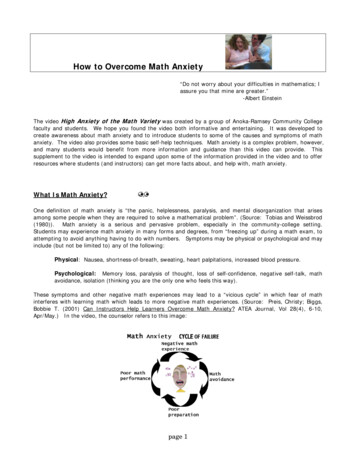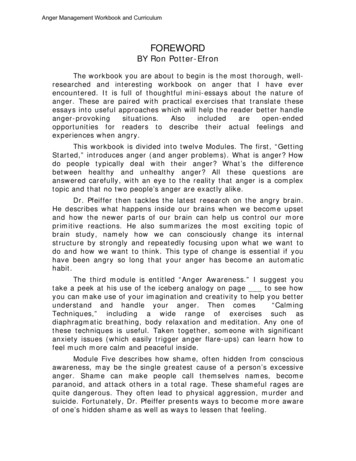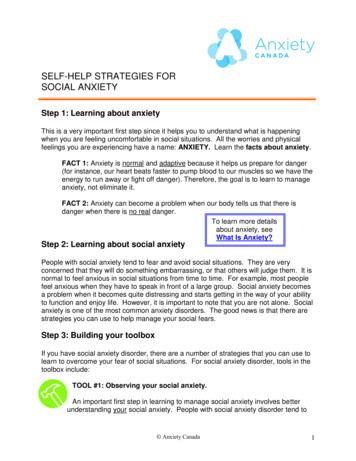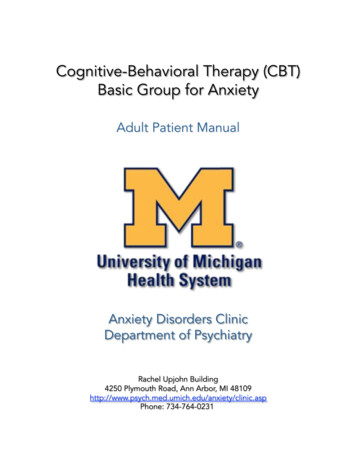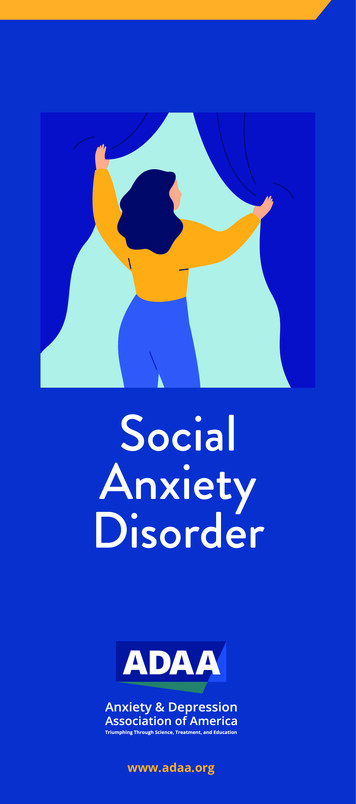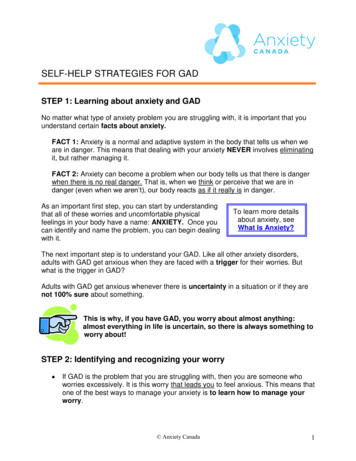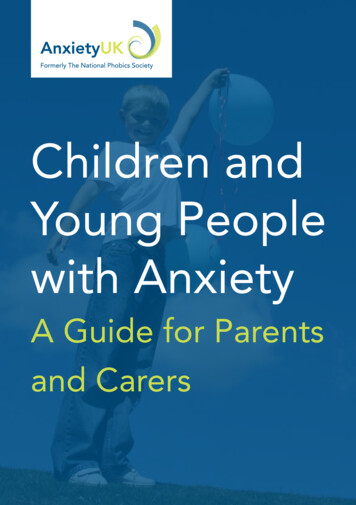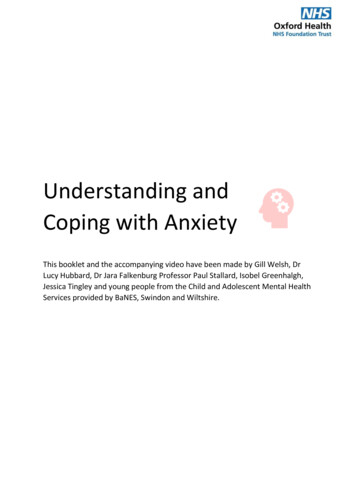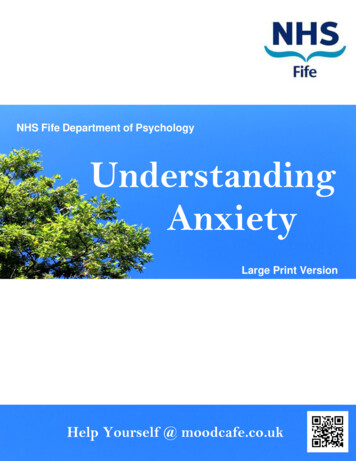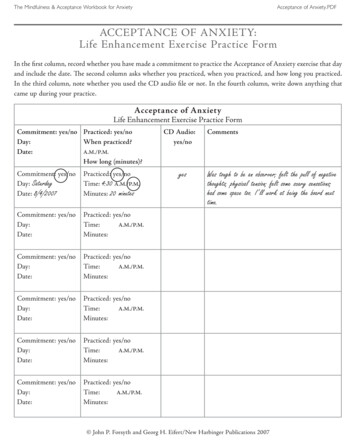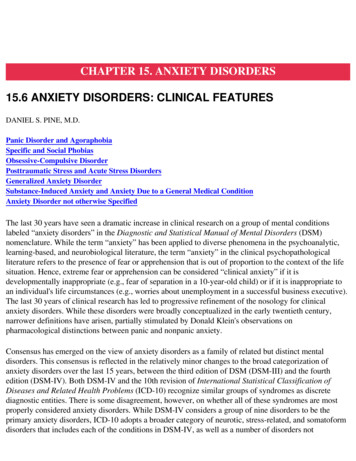
Transcription
15.6 ANXIETY DISORDERS: CLINICAL FEATURESKaplan & Sadock’s Comprehensive Textbook of PsychiatryCHAPTER 15. ANXIETY DISORDERS15.6 ANXIETY DISORDERS: CLINICAL FEATURESDANIEL S. PINE, M.D.Panic Disorder and AgoraphobiaSpecific and Social PhobiasObsessive-Compulsive DisorderPosttraumatic Stress and Acute Stress DisordersGeneralized Anxiety DisorderSubstance-Induced Anxiety and Anxiety Due to a General Medical ConditionAnxiety Disorder not otherwise SpecifiedThe last 30 years have seen a dramatic increase in clinical research on a group of mental conditionslabeled “anxiety disorders” in the Diagnostic and Statistical Manual of Mental Disorders (DSM)nomenclature. While the term “anxiety” has been applied to diverse phenomena in the psychoanalytic,learning-based, and neurobiological literature, the term “anxiety” in the clinical psychopathologicalliterature refers to the presence of fear or apprehension that is out of proportion to the context of the lifesituation. Hence, extreme fear or apprehension can be considered “clinical anxiety” if it isdevelopmentally inappropriate (e.g., fear of separation in a 10-year-old child) or if it is inappropriate toan individual's life circumstances (e.g., worries about unemployment in a successful business executive).The last 30 years of clinical research has led to progressive refinement of the nosology for clinicalanxiety disorders. While these disorders were broadly conceptualized in the early twentieth century,narrower definitions have arisen, partially stimulated by Donald Klein's observations onpharmacological distinctions between panic and nonpanic anxiety.Consensus has emerged on the view of anxiety disorders as a family of related but distinct mentaldisorders. This consensus is reflected in the relatively minor changes to the broad categorization ofanxiety disorders over the last 15 years, between the third edition of DSM (DSM-III) and the fourthedition (DSM-IV). Both DSM-IV and the 10th revision of International Statistical Classification ofDiseases and Related Health Problems (ICD-10) recognize similar groups of syndromes as discretediagnostic entities. There is some disagreement, however, on whether all of these syndromes are mostproperly considered anxiety disorders. While DSM-IV considers a group of nine disorders to be theprimary anxiety disorders, ICD-10 adopts a broader category of neurotic, stress-related, and somatoformdisorders that includes each of the conditions in DSM-IV, as well as a number of disorders not
considered anxiety disorders in DSM-IV. Prior to DSM-III, which brought a relatively major revision tothe nosology of mental disorders in the United States, anxiety disorders were classified in a group ofconditions that included many of the disorders currently listed in DSM-IV along with a set of disordersthat have been reclassified. These reclassified disorders included affective disorders (formerly classifiedas “depressive neurosis”), somatoform and dissociative disorders (formerly classified as “hystericalneurosis”), and neurasthenia, a disorder that was eliminated with the writing of DSM-III.DSM-III, with its emphasis on empiricism and the validity of nosological categories, reclassified anxietydisorders into categories that were quite similar to the disorders included in the current anxiety sectionof DSM-IV, which include panic disorder with and without agoraphobia, agoraphobia with and withoutpanic disorder, specific phobia, social phobia, obsessive-compulsive disorder (OCD), posttraumaticstress disorder (PTSD), acute stress disorder, and generalized anxiety disorder. This chapter reviews theclinical features of these nine conditions, as conceptualized in DSM-IV. This includes the primarysymptomatology, history, epidemiology, differential diagnosis, and course of each disorder, along with aclinical vignette designed to capture the essential features of each disorder as it typically presents in theclinic.PANIC DISORDER AND AGORAPHOBIAThe panic attack is the key feature of panic disorder, which is characterized by a pattern of recurrentpanic attacks. The panic attack is defined as an episode of abrupt intense fear that is accompanied by atleast four autonomic or cognitive symptoms listed in Table 15.6-1. Such episodes of abrupt fear occur inmany situations. For example, a healthy person might experience a panic attack when confronted withsudden extreme danger, and an individual with a phobia of heights might experience a panic attack whenconfronted with the feared situation.Table 15.6-1 DSM-IV Criteria for Panic AttackDSM-IV recognizes three types of panic attacks. The unexpected or spontaneous panic attack occurswithout cue or warning; the situationally bound panic attack occurs upon exposure to, or in anticipationof, exposure to a feared stimulus; and the situationally predisposed panic attack is more likely to occur,but does not necessarily have to occur, on exposure to a situational trigger. In panic disorder, panicattacks occur spontaneously, arising without any trigger or environmental cue. As shown in Table 15.6-
2, panic disorder requires at least two spontaneous panic attacks, at least one of which is associated witheither concern with additional attacks, worry about attacks, or changes in behavior.Table 15.6-2 DSM-IV Criteria for AgoraphobiaPatients with panic disorder present with a number of comorbid conditions, but there has beenconsiderable interest in the relationship between panic disorder and agoraphobia, which refers to fear oranxiety of places from where escape might be difficult (Table 15.6-2). There has in fact been somedebate about whether agoraphobia is best conceptualized as a complication of panic disorder or as aseparate condition. This controversy centers on the frequency with which patients develop agoraphobiain the absence of panic disorder or panic attacks (Table 15.6-3) DSM-IV suggests that such patients doexist, noting the existence of panic disorder with agoraphobia (Table 15.6-4) and without agoraphobia(Table 15.6-5). However, even in agoraphobia without history of panic disorder, agoraphobia isconsidered related to the fear of developing paniclike symptoms.Table 15.6-3 DSM-IV Diagnostic Criteria for AgoraphobiaWithout History of Panic DisorderTable 15.6-4 DSM-IV Diagnostic Criteria for Panic Disorder With Agoraphobia
Table 15.6-5 DSM-IV Diagnostic Criteria for Panic DisorderWithout AgoraphobiaAs with most anxiety disorders, panic disorder often co-occurs with a number of mental conditionsbeyond agoraphobia, particularly anxiety and depressive disorders. These include specific and socialphobia, generalized anxiety disorder, and major depressive disorder. Some data also suggest associationswith substance use disorders, bipolar disorder, and suicidal behavior. While the high comorbidity seen inthe clinic partially reflects referral bias, considerable comorbidity with these anxiety and depressivedisorders is also found in epidemiological studies, which suggests that panic disorder in the communityis frequently compounded by comorbid mental conditions.History and Comparative Nosology While the term “panic disorder” was first coined in DSM-III, asyndrome characterized by recurrent episodes of spontaneous fear has been recognized for more than100 years. This syndrome has been given various labels throughout history, including DaCosta'ssyndrome in the late nineteenth century, and effort syndrome or neurocirculatory asthenia in the earlierpart of the twentieth century. Even Freud's descriptions of “anxiety neurosis” invoked many of the keyfeatures of panic disorder.A major change to the DSM conceptualization of anxiety occurred in 1980, with DSM-III, where panicdisorder was first recognized as a distinct entity. Between 1980 and 1994 one significant change to theconceptualization of the disorder involved refining the view of panic disorder and agoraphobia as tightlylinked constructs. As conceptualized in DSM-IV, agoraphobia invariably involves at least some form ofspontaneous crescendo anxiety, even if such episodes do not meet formal criteria for panic attacks(Table 15.6-3 and Table 15.6-4). In the earlier versions of the DSM and in ICD-10, agoraphobia isconsidered less closely linked to panic disorder. Indeed, ICD-10 classifies agoraphobia as one of many
phobic disorders and does not emphasize the relationship with panic disorder to the same degree asDSM-IV. Table 15.6-6 presents the ICD-10 diagnostic criteria for phobic anxiety disorders, includingagoraphobia. Table 15.6-7 presents the ICD-10 criteria for other anxiety disorders, including panicdisorder.Table 15.6-6 ICD-10 Diagnostic Criteria for Phobic AnxietyDisordersTable 15.6-7 ICD-10 Diagnostic Criteria for Other AnxietyDisordersDifferential Diagnosis Panic disorder with or without agoraphobia must be differentiated from anumber of medical conditions that produce similar symptomatology. Panic attacks are associated with avariety of endocrinological disorders, including both hypo- and hyperthyroid states,hyperparathyroidism, and pheochromocytomas. Episodic hypoglycemia associated with insulinomas canalso produce paniclike states, as can primary neuropathological processes. These include seizuredisorders, vestibular dysfunction, neoplasms, or the effects of both prescribed and illicit substances onthe central nervous system. Finally, disorders of the cardiac and pulmonary systems, includingarrhythmias, chronic obstructive pulmonary disease, and asthma, can produce autonomic symptoms andaccompanying crescendo anxiety that can be difficult to distinguish from panic disorder. Clues of anunderlying medical cause for paniclike symptoms include atypical features during panic attacks, such asataxia, alterations in consciousness, or bladder dyscontrol; onset of panic disorder relatively late in life;or physical signs or symptoms indicating a medical disorder.Panic disorder also must be differentiated from a number of psychiatric disorders, particularly otheranxiety disorders. Since panic attacks occur in many anxiety disorders, including social and specificphobia, posttraumatic stress disorders, or even obsessive-compulsive disorder, the key to correctly
diagnosing panic disorder involves documenting recurrent spontaneous panic attacks at some point inthe illness. Differentiation with generalized anxiety disorder can also be difficult. Classically, panicattacks are characterized by their rapid onset, within minutes, and short duration, usually less than 10 to15 minutes, in contrast to the anxiety associated with generalized anxiety disorder, which emerges anddissipates more slowly. This distinction can be difficult, however, as the anxiety surrounding panicattacks can be more diffuse and dissipate more slowly. Since anxiety is a frequent concomitant of manyother psychiatric disorders, including the psychoses and affective disorders, distinctions between panicdisorder and a multitude of disorders can also be difficult.Course Panic disorder typically has its onset in late adolescence or early adulthood, although cases ofchildhood-onset and late adulthood–onset disorder have been described. Only tentative data exist on thenatural course of panic disorder. The best evidence on the course of any disorder, including panicdisorder, derives from prospective epidemiological research, since both retrospective and clinicallybased studies are vulnerable to biases that preclude firm conclusions on course. Unfortunately, few suchstudies exist. Retrospective or clinical studies suggest that panic disorder tends to exhibit a fluctuatingcourse, with varying levels of persistence over the life span. Approximately one third to one half ofpatients are psychiatrically healthy at follow-up, with most living relatively normal lives, despite eitherfluctuating or recurrent symptoms. Typically, patients with chronic disorders exhibit a pattern ofexacerbation and remissions rather than chronic disability.Ms. S. was a 25-year-old student who was referred for a psychiatric evaluation from the medicalemergency room at a larger university-based medical center. Ms. S. had been evaluated threetimes over the preceding 3 weeks in this emergency room. Her first visit was prompted by aparoxysm of extreme dyspnea and terror that occurred while she was working on a term paper.The dyspnea was accompanied by palpitations, choking sensations, sweating, shakiness, and astrong urge to flee. Ms. S. thought that she was having a heart attack, and she immediately went tothe emergency room. She received a full medical evaluation, including an electrocardiogram(ECG) and routine blood work, which revealed no sign of cardiovascular, pulmonary, or otherillness. Although Ms. S. was given the number of a local psychiatrist, she did not make a followup appointment, since she did not think that her episode would recur. She developed two othersimilar episodes, one while she was on her way to visit a friend and a second that woke her upfrom sleep. She immediately went to the emergency room after experiencing both paroxysms,receiving full medical workups that showed no sign of illness.SPECIFIC AND SOCIAL PHOBIASThe term “phobia” refers to an excessive fear of a specific object, circumstance, or situation. Phobias areclassified on the basis of the feared object or situation, and DSM-IV recognizes three distinct classes ofphobia: agoraphobia (discussed above as it is considered closely related to panic disorder), specificphobia, and social phobia. Criteria for specific and social phobia are shown in Table 15.6-8 and Table15.6-9. Both specific and social phobia require the development of intense anxiety, to the point of evensituationally bound panic, upon exposure to the feared object or situation. Both conditions also require
that fear either interferes with functioning or causes marked distress. Finally, both conditions requirethat an individual recognizes the fear as excessive or irrational and that the feared object or situation iseither avoided or endured with great difficulty.Table 15.6-8 DSM-IV Diagnostic Criteria for Specific PhobiaTable 15.6-9 DSM-IV Diagnostic Criteria for Social PhobiaSpecific phobia is divided into four subtypes (animal type, natural environment type, blood-injectioninjury type, situational type, and other type), with a residual category for phobias that do not clearly fallinto any of these four categories. The key feature in each type of phobia is that the fear is circumscribedto a specific object, both temporally and with respect to other objects. Hence, an individual with specificphobia becomes immediately frightened when presented with a feared object. This fear may relate toconcern about harm from a feared object, concern about embarrassment, or fear of consequences relatedto exposure to the feared object. For example, individuals with blood-injury phobia may be afraid offainting on exposure to blood, and individuals with fear of heights may be afraid of becoming dizzy.Specific phobia often involves fears of more than one object, particularly within a specific subcategoryof phobia. For example, it is common for an individual with a phobia of thunderstorms to also have aphobia of water, both phobias being classified as natural environment type phobias. Further, in theclinical setting, specific phobia often occurs with other anxiety or mood disorders. Since it is rare forpatients to seek treatment for an isolated phobia, some of the comorbidity seen in the clinic reflectsreferral bias. Community-based studies also suggest that specific phobia is associated with other anxietydisorders, although at lower rates than seen in the clinic. Quantifying the impairment associated with aspecific phobia is sometimes difficult, since the comorbid disorders typically tend to cause more
impairment than specific phobia and since individuals with isolated specific phobia are rarely seen in theclinic. Impairment associated with specific phobia typically restricts the social or professional activitiesof the individual.Social phobia involves fear of social situations, including situations that involve scrutiny or contact withstrangers. Individuals with social phobia typically fear embarrassing themselves in social situations (e.g.,social gatherings, oral presentations, or meeting new people). This can involve specific fears aboutperforming certain activities, such as writing, eating, or speaking in front of others. It can also involve avague, nonspecific fear of embarrassing oneself. DSM-IV provides a specifier for the diagnosis of socialphobia. Individuals with social phobia who fear most situations are considered to suffer fromgeneralized social phobia. Such individuals are fearful of initiating conversations in many situations,about dating or participating in most group activities or social gatherings, and about speaking withauthority figures.The clinician should recognize that many patients exhibit at least some social anxiety or selfconsciousness. In fact, community studies suggest that roughly a third of all people consider themselvesto be far more anxious than other people in social situations. Such anxiety only becomes social phobiawhen the anxiety either prevents an individual from participating in desired activities or causes markeddistress in such activities. Individuals with the more specific form of social phobia possess fear ofspecific, circumscribed social situations. For example, extreme anxiety about public speaking thatinterferes with an individual's job performance is a common type of specific social phobia; it would notbe considered generalized social phobia unless it was associated with fears related to many other socialsituations besides public speaking.As with other anxiety disorders, social phobia frequently co-occurs with other mood and anxietydisorders. The association of social phobia with both panic disorder and major depression has receivedconsiderable attention in recent literature. Associations with substance use disorders and childhoodconduct problems have also been documented.History and Comparative Nosology Phobias have been recognized as incapacitating mental disordersfor more than 100 years. The prominent place of phobia in the history of modern mental health scienceis indicated by the major role case histories of phobic patients played in the development of bothpsychoanalytic and cognitive therapies. The category of phobia has undergone progressive refinementover the past 20 years, as research has focused on each of the specific classes of phobia described above.Much of this refinement crystallized in DSM-III, which was based on emerging evidence that phobiasrepresent a group of related but distinct conditions, rather than one heterogenous disorder. Suchevidence included Isaac Mark's work on differentiating social and specific phobias. The refinement inDSM-III categorized agoraphobia as a condition closely related to panic disorder and distinguishedsocial and simple phobia, which was relabeled specific phobia in DSM-IV.The view of phobias has changed since the writing of DSM-III. While discussion of agoraphobia hasemphasized the role of panic since DSM-III, DSM-IV also contains descriptions of paniclike phenomena
in both the specific and social phobia sections, as well as in the discussion of agoraphobia. Beyond thischange, the most significant other change for specific phobia between DSM-III and DSM-IV involvedinclusion of the above subcategories of phobia, based on research noting distinct physiology anddemographics of the subtypes. For social phobia, the most significant other change occurred with therevised third edition (DSM-III-R), which distinguished between generalized and more specific forms ofsocial phobia. This change was based on descriptive phenomenology, epidemiology, and pharmacologystudies that validated the two variants of the condition.The approach to categorization of phobias in the ICD system is quite similar to that in DSM-IV. ICD-10recognizes specific phobia as a distinct category, including the subtypes in DSM-IV. Social phobia isalso classified in ICD-10, although without the qualifier in DSM-IV. Perhaps the major differencebetween DSM-IV and ICD-10 in the consideration of phobia relates to agoraphobia. While DSM-IVemphasizes the relation between panic disorder and agoraphobia, in ICD-10 the term “panic disorder” isrestricted to cases without phobia, and the term “agoraphobia” is applied to all cases that meet criteria,regardless of the presence of absence of panic attacks (Table 15.6-6 and Table 15.6-7).Differential Diagnosis Specific phobia is usually quite easily distinguished from anxiety stemmingfrom primary medical problems by the focused nature of the anxiety, which is not typical of anxietydisorders related to medical problems. The most difficult diagnostic issues involve differentiatingspecific phobia from other anxiety disorder. As DSM-IV emphasizes the presence of paniclikesymptoms with specific phobia, including situationally bound panic attacks, specific phobia must bedifferentiated from panic disorder, in which panic attacks occur without a cue. Specific phobia canoccasionally be confused with PTSD, as both conditions can involve focused fears of specific objects orsituations. The two disorders are most easily differentiated by the marked other features of PTSD, suchas reexperiencing the trauma, avoidance, and enhanced startle, which are absent in specific phobia.Similarly, specific phobia can occasionally be confused with generalized anxiety disorder, as bothconditions may involve worry about exposure to specific situations. The two disorders are differentiatedon the basis of the focused nature of the fear, both over time and with respect to objects, in specificphobia.Like specific phobia, social phobia is rarely confused with anxiety that is the primary result of medicaldisorders. However, the number of psychiatric disorders that are associated with social withdrawal makeit difficult to diagnose social phobia correctly. Perhaps the most difficult distinction involvesdifferentiating social phobia and agoraphobia, since both conditions involve fears of situations wherepeople typically gather. The key distinction between the disorders centers on the nature of the fearedobject. Patients with social phobia are specifically afraid of encountering people; individuals withagoraphobia are afraid of situations from which escape would be difficult but do not specifically fearpeople. Hence, an individual with agoraphobia might be reassured in the presence of other people,provided the physical properties of the location are suitable, while an individual with social phobia fleesother people. The clinician might also encounter difficulty in distinguishing social phobia from thesocial isolation that accompanies a number of psychiatric disorders, including major depression and theearly stages of psychosis. Two factors are essential in making this distinction. First, the individual withsocial phobia must experience anxiety or fear in social situations; individuals who are isolated due to
depression or indolent psychosis often isolate themselves for other reasons. Second, with social phobia,symptomatology is restricted to the fears of social situations; with other disorders social isolation isaccompanied by a broad array of symptoms that are not found in social phobia.Course Specific phobia exhibits a bimodal age of onset, with a childhood peak for animal phobia,natural environment phobia, and blood-injury phobia and an early adulthood peak for other phobias,such as situational phobia. As with other anxiety disorders, limited prospective epidemiological dataexist on the natural course of specific phobia. Because patients with isolated specific phobias rarelypresent for treatment, research on the course of the disorder in the clinic is limited. The information thatis available suggests that most specific phobias that begin in childhood and persist into adulthoodcontinue to persist for many years. The severity of the condition is thought to remain relatively constant,without the waxing and waning course seen with other anxiety disorders.Mr. A. was a successful businessman who presented for treatment following a change in hisbusiness schedule. While he had formerly worked largely from an office near his home, apromotion led to a schedule of frequent out-of-town meetings, requiring weekly flights. Mr. A.reported being “deathly afraid” of flying. Even the thought of getting on an airplane led tothoughts of impending doom as he envisioned his airplane crashing to the ground. These thoughtswere associated with intense fear, palpitations, sweating, clammy feelings, and stomach upset.While the thought of flying was terrifying enough, Mr. A. became nearly incapacitated when hewent to the airport. Immediately before boarding, Mr. A. often had to turn back from the planeand run to the bathroom to vomit.Social phobia tends to have its onset in late childhood or early adolescence. Social phobia tends to be achronic disorder, although as with the other anxiety disorders, prospective epidemiological data arelimited. Both retrospective epidemiological studies and prospective clinical studies suggest that thedisorder can profoundly disrupt the life of an individual over many years. This can include disruption inschool or academic achievement, interference with job performance, and social development.Ms. M. was a successful secretary working in a law firm. While she reported a long history offeeling uncomfortable in social situations, Ms. M. came for treatment when she began to feel thather uneasiness was interfering with her social life and job performance. Ms. M. reported that shenoticed herself feeling increasingly nervous whenever she met a new person. For example, uponmeeting a new member of the law firm, she described feeling suddenly tense and sweaty, noticingthat her heart was beating very fast. She had the sudden thought that she would say somethingfoolish in these situations or commit a terrible social gaffe that would make people laugh at her.At social gatherings she described similar feelings that led her to either leave the gathering earlyor decline invitations to attend.OBSESSIVE-COMPULSIVE DISORDER
Obsessions and compulsions are the essential features of OCD. As shown in Table 15.6-10, anindividual must exhibit either obsessions or compulsions to meet DSM-IV criteria. DSM-IV recognizesobsessions as “persistent ideas, thoughts, impulses, or images that are experienced as intrusive andinappropriate,” causing distress. Obsessions are anxiety provoking, accounting for the categorization ofOCD as an anxiety disorder; they must be differentiated from excessive worries about real life problems;and they must be associated with either efforts to ignore or suppress the obsessions. Typical obsessionsassociated with OCD include thoughts about contamination (“my hands are dirty”) or doubts (“I forgotto turn off the stove”).Table 15.6-10 DSM-IV Diagnostic Criteria for ObsessiveCompulsive DisorderCompulsions are defined as repetitive acts, behaviors, or thoughts that are designed to counteract theanxiety associated with an obsession. A compulsion reduces the anxiety associated with the obsession.While many compulsions are acts associated with specific obsessions, such as hand-washing orchecking, other compulsions can be thoughts. For example, patients may have the obsession that theyhave committed a sin and might relieve the resultant anxiety by repetitively saying a silent prayer tothemselves.Obsessions and compulsions must cause marked distress, consume at least 1 hour a day, or interfere withfunctioning to be considered above the diagnostic threshold. At least during some point in the illness,symptoms of OCD must be recognized as unreasonable for adults, though this varies greatly both acrossindividuals and in a given individual over time. For example, early in the course of the disorder patientsmay recognize their hand washing is excessive or irrational but, over a number of years, lose thisrecognition. DSM-IV recognizes a poor insight subtype of OCD when an individual fails to recognizethe irrational or unreasonable nature of the obsessions. This subtype of OCD has been labeled thepsychotic subtype in some of the clinical literature, prompting trials of antipsychotic pharmacotherapy.The criterion related to insight does not apply to children, who may either not possess the insight torecognize the unreasonableness of their condition or may be too embarrassed to discuss the condition asunreasonable.OCD frequently co-occurs with other disorders. The association with major depression is particularlyprominent, although comorbidity with panic disorder, phobias, and eating disorders is also notuncommon. Finally, OCD exhibits a particularly interesting association with Tourette's disorder.Approximately half of all patients with Tourette's disorder meet criteria for OCD, although less than 10
percent of patients with OCD meet criteria for Tourette's disorder. There is also evidence ofcotransmission of Tourette's disorder, OCD, and chronic motor tics within families.History and Comparative Nosology Descriptions of patients with a syndrome of recurrent obsessionsand compulsions are found in the nineteenth century, when these conditions were viewed as a form of“depressive state.” Descriptions of OCD also played a prominent role in Freud's writings, as captured inthe case history of the Rat Man, and in early learning-based theories that attempted to apply treatmentsdeveloped among patients with phobias to patients with OCD. Research on OCD changed with the ECAstudy in the early 1980s. Prior to this study, OCD was recognized as a discrete but rare entity,stimulating a modest degree of research. The Epidemiologic Catchment Area (ECA) Study noted thatOCD had a prevalence in excess of 1 percent in the population and was associated with markedimpairment
phobia, generalized anxiety disorder, and major depressive disorder. Some data also suggest associations with substance use disorders, bipolar disorder, and suicidal behavior. While the high comorbidity seen in the clinic partially reflects referral bias, considerable comor

